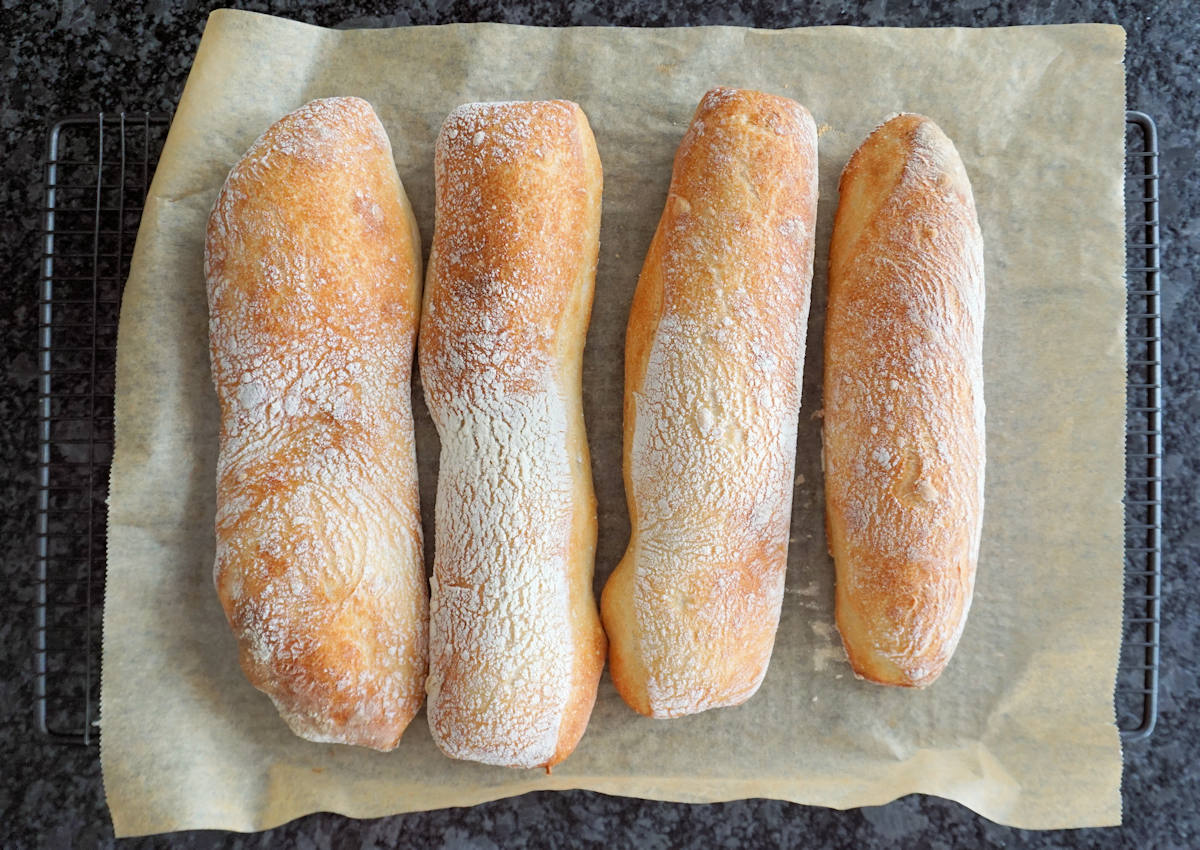Pan de cristal is Spanish bread that has more air than crumb and the crust is as brittle as glass. Not very appetising? Wait till you try…

What is pan de cristal?
Pan de cristal means ‘glass bread’. I couldn’t fail to give it a go with an intriguing name like that!
You might know it from tapas restaurants as pan con tomate, usually overlooked in the menus because bread with tomato doesn’t sound exciting. More fools you!
Those inconspicuous tiny slices of pale bread sinking under the load of diced tomato and pools of olive oil are the best, if baked on site as they should be in self-respecting outfits.
High hydration Gen Z-er
Pan de cristal, crystal bread or more commonly named 'glass bread' is typical for Catalonia.
It is often compared to Italian ciabatta, as both are high hydration breads, as well as relatively recent inventions.
But while ciabatta goes back to 1980s, pan de cristal is a Gen Z! It was invented as recently as 2004 by a Barcelona baker Jordi Nomen, who decided to bake a loaf of bread with non-existent crumb, to prove that bread didn’t make you fat.
And so it is, nearly non-existent, like a honeycomb with more holes than structure. The crust is delicate and brittle – hence ‘glass bread’.
How is it achieved?
I mentioned already high hydration, but those not au fait with baking intricacies, even if they bake a loaf occasionally, will be puzzled.
The hydration of the dough is the ratio of water to flour in bread dough. Ordinary breads, sourdough or not, hover around 60% (it’s not a rule of course), which means that for, say, 500g of flour the bread uses 300ml of water.
High hydration breads have the water-flour ratio closer to 80% which means the amount of water crawls closer towards matching that of flour.
Pan de cristal’s hydration is about 90%.
What is the effect of high hydration?
Just like in pan de cristal or ciabatta: so called ‘open crumb’ which means lots and lots of air bubbles. It makes the bread light and puffy – but it also means sometimes butter drops out onto the floor...
High hydration is hard work though. The dough is sticky, runny, and trying to stretch it, fold it and give it some semblance of structure is like trying to fold soup.
Pan de cristal dough
The good thing about high hydration dough is that you can easily mix it with a wooden spoon because it’s so runny. The ease ends there because if you tried to knead it - well, as I said, try to knead soup.
The method employed here is folding instead of kneading. It takes about six folding sessions, between half an hour rests, to get an approximation of coherence and a hope of being able to shape the loaves.
The dough still rolls about like mercury from the old-fashioned thermometers so the loaves are really strips cut with a bench scraper and handled with copiously floured hands.
Baking glass bread
The baking is best done on a baking stone or steel, with some steam generated by spraying the oven with water when the bread goes in, or a dish set at the bottom of the oven splashed with boiling water.
And the bread is transferred into the oven and baked on the parchment sheet, which makes the process not just easier but actually feasible.
The outcome is gorgeous: chewy, almost-no-crumb bread sticks that are obviously gorgeous sliced and topped with ripe tomatoes but, halved horizontally, also make great bruschettas or toasties.
Surplus can be frozen and lightly toasted before serving again.
More high hydration bread recipes
The Italian counterpart, ciabatta, means ‘old slipper’ and is pronounced ‘cha-bah-ttah’. My coccodrillo, or little crocodiles, is absolutely the best recipe for homemade ciabatta loaves.
Off to Germany, for Seelen which means souls in German, and in Schwabia it means fantastically tasty spelt sourdough bread rolls, rustic and completely artisan.
The Portuguese have their own version, pão de água or water bread. It is a white sandwich loaf that’s light, airy and fluffy inside and has a wonderfully crunchy crust on the outside.
More Spanish recipes
Spinach and cheese empanada wrapped in filo pastry and baked in the oven, with honey and pine nuts topping. Spanish empanada meets Greek spanakopita!
Padron peppers, pimientos de padron, a Spanish dish of pan-blistered padron style green peppers. A delicious snack from the tapas menu, they can be eaten whole.
Roasted peppers salad with soft cheese recipe; red peppers roasted under the grill and skinned, tossed with spiced dressing and served with soft cheese or feta.